December 2016
STAR Newsletter
December 2016 edition
Contents:- RHICf for Run 17
- From the Spokesperson
- Software & Computing Update
- STAR's Event Plane Detector: 1/8th delivered, 8/8ths funded!
- BES Physics Workshop and iTPC Internal Review
A note from the editor: as a collaboration-wide communication tool, this newsletter is set up to allow comments (subject to moderation against abuse), and all STAR Collaborators are welcome to do so! Please keep in mind that some content (including all comments) may be considered internal to the Collaboration and only accessible when logged into Drupal. Documentation is available here.
RHICf for Run 17
(Takashi Sako, Yuji Goto, & Itaru Nakagawa - RHICf Collaboration)
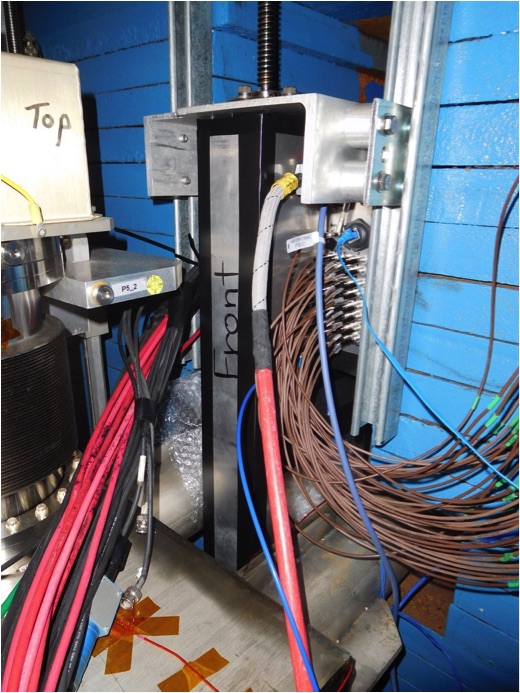
RHICf detector installed in front of the ZDC.
The RHICf detector was the former LHCf Arm1 detector which has measured forward particles at LHC. One of the motivations of RHICf is to study the particle production for cosmic-ray physics. Cosmic-ray physicists observe high-energy cosmic rays through atmospheric air showers, and its analyses need Monte Carlo simulations relying on a hadronic interaction model. By using the results from RHICf and LHCf, hadronic interaction is understood in a wide range of collision energies corresponding to the cosmic-ray energies of 1014 eV to 1017 eV. This will reduce the uncertainty in the cosmic-ray analyses to reveal their origin.
The 1 mm position resolution for hadronic showers improves the former measurements of the single-spin asymmetry of forward neutron production in polarized p+p collisions reported by RHIC experiments. Though PHENIX indicated pT dependence of AN and it was theoretically explained by interference of pion and a1 exchange, the limited coverage and resolution in pT prevent a definitive conclusion on the production mechanism of forward neutrons. RHICf will provide AN in a wider pT range both in lower and higher sides.
At the end of 2016, RHICf succeeded with a test installation of the detector in the RHIC tunnel and commissioning of data acquisition. Before the dedicated operation, RHICf will install the detector ‘near’ the beam pipe but not in front of the ZDC to avoid interference. Preparation of joint data-taking with STAR is ongoing. RHICf has been allocated an operation space in the STAR Control Room and will continue to test joint data-taking at the beginning of Run 17 in January to February. RHICf expects its dedicated beam time in late May to early June.
Additional information can be found at these links:
RHICf BUR for Run 17
LHCf official web page
From the Spokesperson
(Zhangbu Xu - Spokesperson)
Dear Collaborators:
Season's greetings to all the collaborators. It is hard to believe that another year has gone by!
This year is a good year. There have been 11 scientific journal publications and 11 submissions during the 2016 calendar year with many exciting results. The beam energy scan has been continuing to be productive. In addition, we have published a few high-impact papers related to jets and Spin. Preliminary results from the HFT have turned into papers, and the first paper on D0 elliptic flow is in the collaboration review. A new program on Global Hyperon Polarization has generated considerable excitement as well. And we have already released preliminary results on W-boson longitudinal spin asymmetry from the Run 13 dataset, plus transverse single spin asymmetry in p+Au and p+p from Run 15, and J/ψ & Υ results from the MTD.
We have successfully taken large datasets in Run 16 with 2 billion minbias events and integrated luminosity of 20 nb-1 for MTD (Runs 14+16). The heavy-flavor tracker has completed its mission and the subsystem as a whole was taken out from the interaction point. The old beam pipe and support cone have been re-installed. We are getting ready for Run 17, starting from February 6th with a nominal 24-cryo-week run. The latest Run schedule is available here. Many subsystems have been added and prepared for the new RHIC Run: RHICf, 1/8th of EPD, FMS UV system, FMS post-shower detector. I would like to thank all the subsystem project teams and STSG group for keeping the detectors at their best year after year.
With the efforts and collaboration between the S&C group and NERSC at LBNL, we have secured 20 million hours of CPU time for STAR data production at Cori, the new supercomputing center at LBNL, starting in January 2017. This will considerably alleviate the backlog of our data production from the last three Runs. Congratulations go to the S&C group.
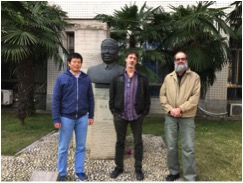
STAR Collaboration Spokesperson Zhangbu Xu with Mike Lisa and Flemming Videbaek (left-to-right) in Hefei.
The EPD proposal was submitted to Chinese Minister of Science and Technology (MoST) in December 2015 and to BNL after STAR internal review in May 2016. Please read the EPD contribution to this Newsletter to find the good news about its funding. Congratulations go to the collaborating project team from OSU, LBNL, Lehigh, BNL, IU, CCNU, and USTC.
There will be a one-day joint CBM and STAR workshop in Darmstadt on March 18th, 2017. The principal focus of the workshop will be the physics of the Beam Energy Scan II (BES-II) at RHIC scheduled for 2019-2020 in connection with CBM physics now scheduled for 2024. We are planning to install an end-cap time-of-flight system at STAR utilizing CBM TOF modules for BES-II as part of the FAIR Phase 0 program. The workshop will immediately precede the CBM collaboration meeting at GSI scheduled for March 19th-24th. A website with more details will be announced in a few weeks. Please mark your calendar. I would like to take this opportunity to thank Tetyana Galatyuk, Geary Eppley, and Nu Xu for organizing this workshop. I am looking forward to a fruitful discussion and future collaboration.
As reported in the last Newsletter, a committee reviewed a possible installation of a hadronic calorimeter (FCAL) in the east tunnel for Run 17 and beyond. The report is available here. STAR Management voted 6:4 (No:Yes) on whether we should support the project as presented for Run 17.
A few institutions have joined STAR in 2016: Southern Connecticut State University (Prof. Evan Finch), Lamar University (Prof. Jim Drakenberg), University of California at Riverside (Prof. Ken Barish & Prof. Richard Seto), Technische University at Darmstadt (Prof. Tetyana Galatyuk), and University of Tsukuba (Prof. ShinIchi Esumi). I am looking forward to their participation.
I wish you a happy holiday and look forward to your continued participation in this unforgettable journey.
Sincerely,
Zhangbu Xu
Software & Computing Update
(Gene Van Buren - S&C Co-Leader)
Over the past few months, the S&C Team has continued its usual efforts to get datasets ready for and through production. Along with completing production of other Run data (see this useful summary), we have successfully delivered on a goal of providing 1/3rd of the Run 16 200 GeV Au+Au by the end of 2016 for use in upcoming Quark Matter presentations. The Run 16 d+Au datasets at various energies are targeted to come next. While storage space to provide live access of production output for analyses remains severely constrained (noted previously), the PicoDST format has been integrated and is helping reduce consumption of that space. The S&C Team also has not let up on efforts to gain processing resources, and has secured 20 million CPU-hours on the Cori High Performance Computing facitiy at NERSC, available to us in January.

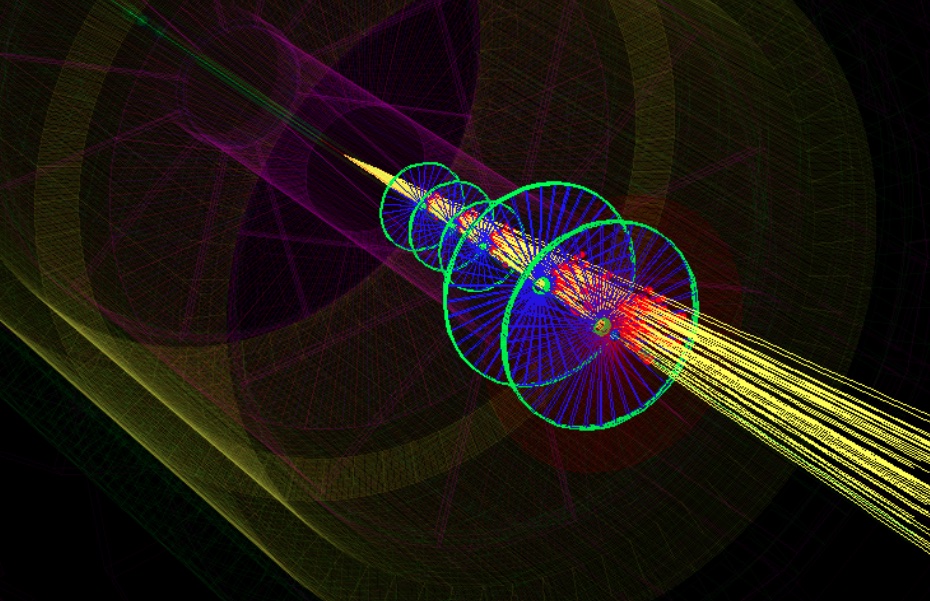
High density forward tracking simulation.
In October, several members of STAR (many from the S&C Team) participated in the 22nd International Conference on Computing in High Energy and Nuclear Physics held in San Francisco, California (CHEP2016). Work on many fronts was highlighted, including (in no particular order) R&D on tiered storage caching techniques (shown by Michael Poat), distributed data production (Dzmitry Makatun), primary vertex finding (Dmitri Smirnov), tracking with the HFT (Jason Webb), misalignments in simulated geometry (Jason Webb), message queue integration with online control systems (Dmitry Arkhipkin), and utilizing high performance computing resources (Mustafa Mustafa). The conference organization included our own Jérôme Lauret on the International Advisory Committee, and Gene Van Buren on the Program Committee.
R&D continues in many areas already noted. Additionally, the S&C Team has resumed close work with fellow STAR collaborators involved in pursuing forward tracking upgrades. Supplementing prior work by the same interested parties, the recent work has explored using small thin gap chamber (sTGC) technology as You do not have access to view this node.
STAR's Event Plane Detector: 1/8th delivered, 8/8ths funded!
(Mike Lisa - Ohio State University)
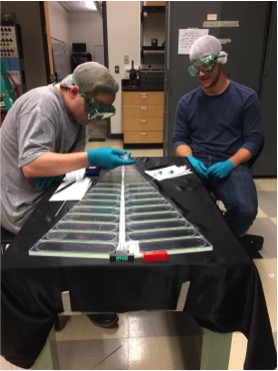
Isaac Upsal and Joey Adams from the Ohio State University glue fibers in Supersector 02.

EPD Project Leader Alex Schmah in front of the strongback where it is mounted for Run 17.
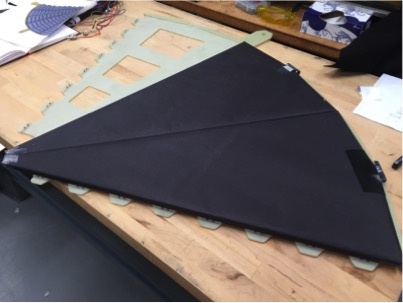
At BNL, two of the three supersectors in this year's quarter-wheel sit in the fiberglass mount.
Three supersectors (plus a spare) of the Event Plane Detector (EPD) have been delivered to BNL and will be installed in STAR for the 2017 run. Composed of 31 scintillating tiles, each supersector covers 30 degrees in azimuth and an eta range of 2-5. The EPD will replace the Beam-Beam Counters (BBC) beginning in 2018, providing improved event-plane resolution and centrality definition capabilities important for the second phase of STAR's Beam Energy Scan. For this year's commissioning run, the quarter-wheel will sit behind the BBC on the east side of STAR The hardware was constructed at LBNL, BNL, Ohio State, and Lehigh. Gerard Visser at Indiana University designed and implemented the front-end electronics. STAR's trigger group and Operations Support guide integration into STAR DAQ and physical structure.
Run 17's installation comprises one eighth of the eventual detector, and was funded by Brookhaven. This year, Professor Ming Shao, from the University of Science and Technology of China (USTC), requested funding for completion of the project from China's Ministry of Science and Technology. Just this month, Prof. Shao shared the good news that this funding has been approved!
Purchase orders for material (scintillator, fibers, silicon photomultipliers) will go out next month. The supersectors will be constructed in 2017 at Ohio State, with crews including students from OSU, USTC, Shanghai, and National Cheng Kung University. Fiber bundles will be constructed at Lehigh and LBNL, and electronic orders and testing will be handled by USTC.
BES Physics Workshop and iTPC Internal Review
(Flemming Videbaek - Upgrades Leader)

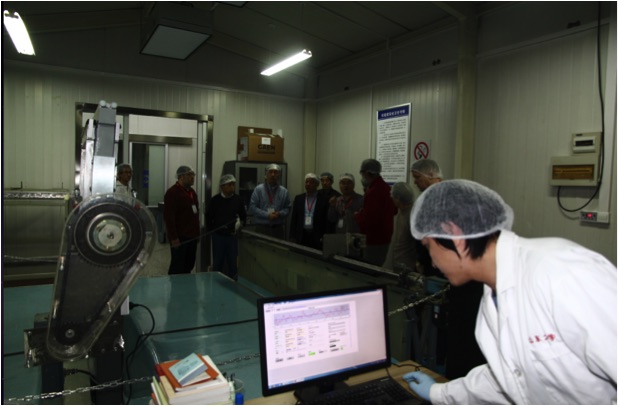

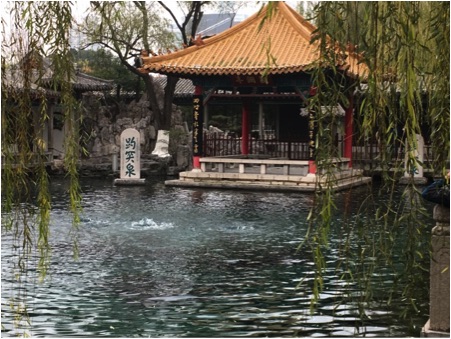
Clockwise from upper-left:
workshop participants at Shandong University;
wire winding in the iTPC lab;
a quiet corner of the Shandong campus;
the famous springs in Jinan.
The Shandong University group in STAR arranged a workshop to be held on the weekend of December 3rd-4th with the purpose of combining an internal review of the iTPC readout chamber construction with talks relevant to the BES program for STAR at RHIC. The meeting was organized by Qinghua Xu and was well-attended by the STAR Chinese colleagues and a U.S. contingent. The physics talks covered an overview of the BES program by Dan Cebra, flow measurements by Shushi Shi, EPD progress by Michael Lisa, an overview of the STAR program by Zhangbu Xu, Strangeness measurements by Xianglei Zhu, properties of hyperon decays by Neha Shah, and a talk by Wangmei Zha on investigating close impact electromagnetic production of J/ψ. There were also several theoretical talks by Xuguang Huang, Mei Huang, Huichao Song, and Jian Deng covering aspects of the nuclear phase diagram and properties near the critical point. There were lots of good discussions at the meetings! Talks can be found at the workshop Indico page.
Ahead of this meeting there was a smaller gathering of people interested in the EPD progress at USTC in Hefei. As noted in another contribution to this Newsletter, this project has just been approved for funding by MoST, China, a very good contribution to the STAR program.
Finally, Mike Lisa gave a talk at both universities on hyperon polarization, which prompted lots of discussion with local theorists.
Previous Edition: October 2016
Groups:
- Printer-friendly version
- Login or register to post comments
